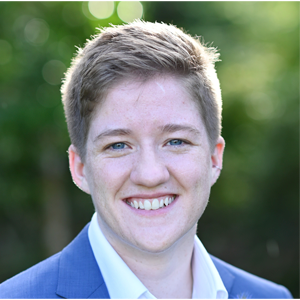Student Spotlight: Aleia Bellcross

By Ruth Barrera
Aleia Bellcross is a graduate student, born and raised outside of Madison, Wisconsin. Aleia moved down south to Georgia when she was in high school and attended the University of Georgia where she received degrees in chemistry and environmental chemistry.
What made you decide to attend Northwestern University?
Ultimately, I was attracted to the opportunities for collaboration and joint mentorship, which I felt would really expand my abilities and experiences. My wife was also interested in attending Kellogg’s MBA program, so coming here was an easy decision for the both of us. She just found out she was accepted into the program (woohoo!), so we will be looking to graduate together in Spring 2023.
What has been your favorite Chemistry class and why?
My favorite class was probably Surface Science and Spectroscopy, taught by Nathan Guisinger from Argonne National Laboratory. The class was technique based and gave me a good foundation in surface science techniques, which has helped me in my research throughout the years.
Is there a professor that has made an impact on your academic career?
I’ve had several professors who have helped to set me on the path I’m on today, but I’d probably have to give the most credit to my undergraduate advisor, Dr. Geoffrey Smith at UGA. He introduced me to the world of experimental atmospheric chemistry, showing me that I could marry my interests in chemistry and the environment through researching brown carbon aerosols in his lab. Dr. Smith encouraged me to apply to graduate school and helped me build the research background I needed to progress to the next level.
How did you become interested in your research?
My work in undergrad with brown carbon aerosols really got me interested in atmospheric chemistry as a whole. I enjoyed how small and well connected the field is, everyone sort of knows everyone else. I knew I wanted to continue studying atmospheric chemistry in graduate school, and the collaboration between Franz Geiger and Regan Thomson studying secondary organic aerosols (SOAs) was the perfect fit.
Tell us more about the research you are conducting in Professor Geiger’s and Thomson’s Labs?
In Regan Thomson’s lab I use organic synthesis to make standards of terpene-derived oxidation products believed to exist in biogenic SOAs, varying their chemical structure and stereochemistry to increase the diversity of our sample set. I then take those standards and probe their atmospherically relevant physical properties–including their solubility, surface orientation, and surface tension depression capabilities. In Franz Geiger’s lab we use surface-specific techniques like sum frequency generation (SFG) spectroscopy to probe these compounds at atmospherically relevant interfaces. I’m currently working with a fellow student to develop a new SFG line to probe free flowing aerosol particles.
How would you explain what you study to non-scientists and what are some potential applications for what you’re doing?
I study small dust-sized particles called biogenic secondary organic aerosols (SOAs). SOAs float around in our troposphere, where they both directly scatter and absorb UV radiation, and then indirectly affect climate by acting as seeds for cloud formation. I study the individual chemical components of the particles, and how those components influence the ability of the particle to seed a cloud. Understanding SOAs on a small scale helps modelers generate more accurate climate models.
We understand you’re involved in the NU Prison Education Program; can you tell us more about the program?
I am! I currently serve as the Co-Director of Student Wellness for the NU Prison Education Program (NPEP). NPEP is a 4-year liberal arts degree granting program operating in the max security men’s prison at Stateville, as well as the women’s prison at Logan. Students take 2-3 courses each quarter, taught by Northwestern faculty and graduate students, as well as faculty at Oakton Community College. NPEP is an incredible organization to be involved in and working with these men and women has been a highlight of my graduate career. These students are some of the kindest, smartest, and most motivated people I’ve had the honor to work with, and I would highly recommend getting involved as a volunteer if you have the time. The program is always looking for more volunteers to help with tutoring and fundraising.
What has been the highlight of your academic career thus far?
Applying for, and then receiving the National Science Foundation Graduate Research Fellowship during my first year was definitely a highlight. I also had the opportunity recently to go speak to some 6th and 12th graders about clouds and climate change, which was a lot of fun.
Where do you hope to be in your career in the next 10 years?
Right now, I envision being involved in some type of science communication or environmental consulting. I love talking to non-scientists about science, and I think working with corporations or organizations to help them become more environmentally conscious would be my ideal career.
